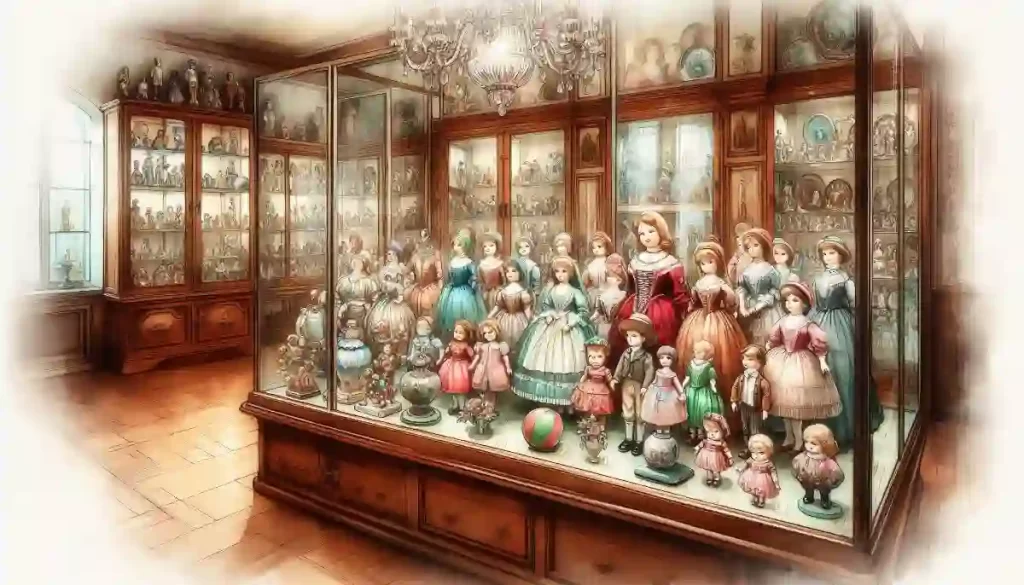Dolls and Figurines
Pop Culture Dolls and Figurines: Why We Love Collecting Them
Table of Contents
Why We Love Collecting Them
From the big screen to collector shelves, pop culture dolls have taken on a life of their own. They are bold, nostalgic, and totally display-worthy. These figures often reflect our most beloved characters, celebrities, and media moments, serving as emotional touchpoints that connect fans to their favorite franchises. Whether it’s a detailed movie-inspired figurine or a stylized version of a pop star, these collectibles hold real meaning for enthusiasts around the world.
The popularity of pop culture dolls has soared thanks to their ability to capture iconic visuals and stories in tangible form. Collectors value them not only for nostalgia but also for their artistry, rarity, and investment potential. This article explores the rise of pop culture dolls and figurines, from their role in entertainment to their booming presence on social media and in collector circles. We’ll also examine how limited edition dolls and figurines are driving excitement in fan communities and provide tips on how to collect pop culture dolls effectively.
Movie and TV Show-Inspired Figures
One of the most enduring and widespread categories of pop culture dolls is the realm of movie-inspired figurines. These dolls and figures allow fans to relive cinematic magic by owning miniature versions of their favorite characters. The global success of franchises like Star Wars, Marvel, Harry Potter, and Stranger Things has created entire universes of collectibles, from action-packed heroes to beloved side characters.
Movie-inspired figurines appeal to both casual fans and serious collectors. For example, a limited-run Darth Vader figure with detailed armor or a lifelike Eleven figurine from Stranger Things isn’t just a display item—it’s a representation of cultural obsession. Pop culture dolls like these often come with accessories, interchangeable faces, or even articulation, giving them dynamic appeal across all ages.
The popularity of these dolls goes beyond play. Adults proudly showcase their collections on shelves, in curated displays, or in protective cases. These items bridge generational gaps too, with many parents introducing their children to the same characters they loved growing up—through the very same or similar figures. The combination of storytelling, nostalgia, and high-quality design has ensured that movie-inspired figurines remain at the heart of pop culture doll collecting.
Celebrity Dolls and Figurines
In the world of pop culture dolls, few subcategories are as instantly recognizable as celebrity collectible dolls. These figures immortalize real-life stars in miniature form, capturing iconic looks, memorable performances, and historic moments. From classic icons like Marilyn Monroe to modern-day legends like Beyoncé, these dolls serve as a unique way for fans to honor the celebrities they admire.
Barbie has long been a leader in this space, releasing special editions of celebrity dolls that commemorate fashion, music, and film legends. A Beyoncé Homecoming doll, for example, doesn’t just replicate her outfit—it pays tribute to a culturally significant performance that captivated millions. Similarly, dolls modeled after actors like Zendaya or Lady Gaga capture distinct style moments that fans associate with empowerment, creativity, and bold identity.
These celebrity collectible dolls are often more than mass-market items. High-end versions are produced in limited runs, meticulously designed by artists who specialize in recreating intricate costumes and lifelike features. Fans and collectors alike are drawn to the nostalgia, admiration, and inspiration these figures represent. By owning such dolls, collectors keep a tangible connection to the artistry and legacy of their favorite stars.
Limited Edition Collaborations and Crossovers
Another major driver of interest in pop culture dolls and figurines is the increasing popularity of limited edition dolls and figurines created through brand collaborations. These special releases often bring together the creative forces of entertainment franchises and top toy manufacturers to produce exclusive collectibles that are only available for a short time—or in limited quantities.
A well-known example includes Mattel’s collaborations with the Marvel and DC universes, where popular collectible figurines were released featuring crossover characters like Wonder Woman in reimagined historical costumes or Iron Man with exclusive battle gear. Such collaborations are often announced at conventions like San Diego Comic-Con, where fans queue for hours to grab these sought-after items.
Crossovers are equally exciting. When different franchises or cultural icons are blended into one product—like a mash-up of Batman with Ninja Turtles or Barbie meets Star Trek—it creates buzz and curiosity. These products are often viewed as collector’s gold, especially if they come with certificates of authenticity or are part of numbered releases.
The scarcity of these limited edition dolls and figurines contributes to their desirability. Collectors may purchase them with resale in mind, anticipating a rise in market value. Others cherish them as personal treasures, thrilled to be part of a community that celebrates creativity, exclusivity, and fandom through tangible art.
How to Collect Pop Culture Dolls and Figurines
Learning how to collect pop culture dolls can be both exciting and overwhelming. With so many franchises, celebrities, styles, and releases to choose from, collectors often approach their hobby in very personal ways. Whether you’re an enthusiastic beginner or a seasoned aficionado, it’s important to develop a strategy that aligns with your interests and budget.
For starters, many collectors focus on a specific theme, such as movie-inspired figurines or celebrity collectible dolls. This niche approach allows for deeper appreciation of the subject matter and often leads to discovering rare or exclusive items that others overlook. For example, a collector focused solely on Star Wars memorabilia may seek out vintage Princess Leia figures from the 1980s, while a fan of music icons might prioritize dolls modeled after Taylor Swift or BTS.
Condition and authenticity are also key considerations. Popular collectible figurines are most valuable when they are kept in pristine condition, ideally in their original packaging. Limited edition dolls and figurines often come with certificates of authenticity or special branding—features that significantly increase their worth over time.
Online marketplaces such as eBay, Etsy, and specialist collector forums are valuable resources. Social media groups and conventions offer opportunities to network, trade, and learn from others who share the same passion. Establishing connections within the community can open doors to exclusive drops and insider knowledge about upcoming releases or restocks.
Collecting should remain joyful and sustainable. Rather than chasing every new release, focus on the pieces that truly resonate with your personality, values, or nostalgic memories. Remember, the most fulfilling collections are not always the most expensive—they’re the ones that tell a meaningful story.
Impact of Social Media on Pop Culture Dolls and Figurines
Social media has radically changed how fans discover, buy, and engage with pop culture dolls. Platforms like Instagram, TikTok, and YouTube have turned collectors and influencers into tastemakers, shaping trends and driving demand for specific limited edition dolls and figurines.
Unboxing videos are especially influential. When a well-known collector reveals the latest release of a movie-inspired figurine or showcases a rare celebrity collectible doll, followers take notice. These videos generate buzz, create a sense of urgency, and often cause certain figures to sell out within minutes of release. Influencers with a large following can single-handedly launch a product into viral success.
Instagram also serves as a visual portfolio for collectors. High-quality photos, creative dioramas, and tagged collaborations with toy companies elevate the visibility of certain collections. This visual storytelling transforms the collecting experience into a form of art, where the doll or figurine becomes the centerpiece of an aesthetic narrative.
For brands, the benefit is twofold. Social media allows for direct engagement with fans and immediate feedback on new releases. Companies now design with virality in mind—crafting figures that are not only meaningful to fans but also “Instagrammable” enough to attract online attention.
As collectors post, share, and engage, they help build a living, breathing archive of pop culture in doll form—where fandom, creativity, and community thrive in the digital space.
Why We Love Pop Culture Dolls
Pop culture dolls and figurines offer far more than surface-level entertainment—they provide emotional connection, cultural relevance, and creative inspiration. Whether one is captivated by movie-inspired figurines, celebrity collectible dolls, or limited edition dolls and figurines released during collaborations, these cherished items represent moments, characters, and experiences that resonate deeply with fans.
For many collectors, these figures are a way to preserve childhood memories or celebrate ongoing fandoms. For others, they are artistic expressions and valuable collectibles. Social media has only amplified this passion, allowing collectors to showcase their treasures, discover new releases, and connect with a vibrant global community.
As the popularity of pop culture dolls continues to grow, so too does the appreciation for the stories, craftsmanship, and emotions behind them. Whether you’re just learning how to collect pop culture dolls or have already curated a display of popular collectible figurines, the joy is universal: these figures make the intangible tangible, turning pop culture into something you can see, touch, and treasure for years to come.
FAQs – Pop Culture Dolls and Figurines: Why We Love Collecting Them
What makes a pop culture doll or figurine valuable?
The value of a pop culture doll or figurine depends on factors such as rarity, condition, and demand. Limited edition releases or figures that have been discontinued often become more valuable over time, especially if they remain in their original packaging.
How has social media changed the doll and figurine industry?
Social media has given collectors a platform to showcase their collections, connect with others, and influence trends. Influencers who specialize in unboxing and reviewing dolls and figurines can create demand for specific items, and brands use platforms like Instagram to build hype around new releases.
What are some of the most popular pop culture doll collaborations?
Some of the most popular collaborations include Mattel’s Barbie with Star Wars, Marvel, and Harry Potter franchises. Other sought-after figures include those inspired by movies like Frozen and The Avengers, as well as celebrity dolls modeled after stars like Beyoncé and Lady Gaga.
Why do adults collect pop culture dolls and figurines?
For many adults, collecting pop culture dolls and figurines is about nostalgia and connecting with their favorite characters, movies, or celebrities. Others see it as an investment, as certain rare and limited edition figures can increase in value over time.
Are pop culture dolls considered toys or collectibles?
While pop culture dolls can be toys, they are often seen as collectibles, especially when they are part of limited edition releases or inspired by specific movies, TV shows, or celebrities. Many collectors keep their figures in mint condition, hoping their value will increase over time.
Cross, G. (1997). Kids’ stuff: Toys and the changing world of American childhood. Harvard University Press.
Forbes. (2023). The rise of collectible dolls in pop culture. https://www.forbes.com/sites/popculture-collectibles
Smithsonian Institution. (2020). The cultural impact of dolls and figurines in society. https://www.si.edu/newsdesk/dolls-impact
Toy Association. (2022). Trends in the toy industry: Pop culture and beyond. https://www.toyassociation.org/ta/research


